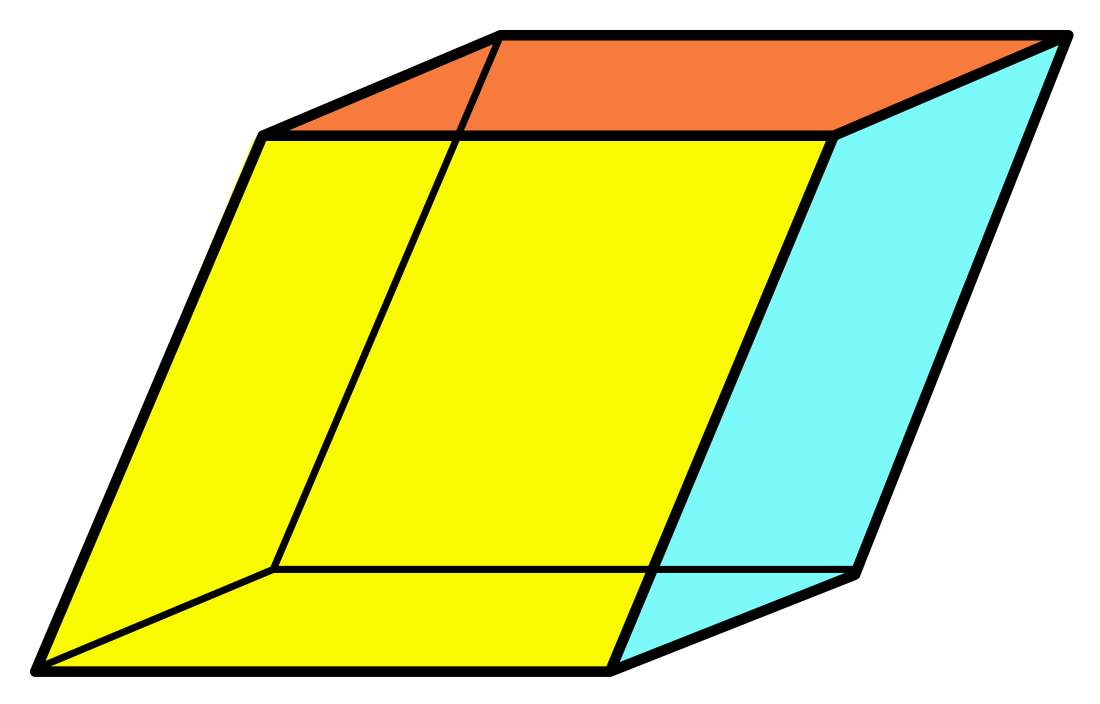Top Qs
Timeline
Chat
Perspective
Rhombohedron
Polyhedron with six rhombi as faces From Wikipedia, the free encyclopedia
Remove ads
In geometry, a rhombohedron (also called a rhombic hexahedron[1][2] or, inaccurately, a rhomboid[a]) is a special case of a parallelepiped in which all six faces are congruent rhombi.[3] It can be used to define the rhombohedral lattice system, a honeycomb with rhombohedral cells. A rhombohedron has two opposite apices at which all face angles are equal; a prolate rhombohedron has this common angle acute, and an oblate rhombohedron has an obtuse angle at these vertices. A cube is a special case of a rhombohedron with all sides square.
| Rhombohedron | |
|---|---|
 | |
| Type | prism |
| Faces | 6 rhombi |
| Edges | 12 |
| Vertices | 8 |
| Symmetry group | Ci , [2+,2+], (×), order 2 |
| Properties | convex, equilateral, zonohedron, parallelohedron |
Remove ads
Special cases
Summarize
Perspective
The common angle at the two apices is here given as . There are two general forms of the rhombohedron: oblate (flattened) and prolate (stretched).
In the oblate case and in the prolate case . For the figure is a cube.
Certain proportions of the rhombs give rise to some well-known special cases. These typically occur in both prolate and oblate forms.
Remove ads
Solid geometry
Summarize
Perspective
For a unit (i.e.: with side length 1) rhombohedron,[4] with rhombic acute angle , with one vertex at the origin (0, 0, 0), and with one edge lying along the x-axis, the three generating vectors are
- e1 :
- e2 :
- e3 :
The other coordinates can be obtained from vector addition[5] of the 3 direction vectors: e1 + e2 , e1 + e3 , e2 + e3 , and e1 + e2 + e3 .
The volume of a rhombohedron, in terms of its side length and its rhombic acute angle , is a simplification of the volume of a parallelepiped, and is given by
We can express the volume another way :
As the area of the (rhombic) base is given by , and as the height of a rhombohedron is given by its volume divided by the area of its base, the height of a rhombohedron in terms of its side length and its rhombic acute angle is given by
Note:
- 3 , where 3 is the third coordinate of e3 .
The body diagonal between the acute-angled vertices is the longest. By rotational symmetry about that diagonal, the other three body diagonals, between the three pairs of opposite obtuse-angled vertices, are all the same length.
Relation to orthocentric tetrahedra
Four points forming non-adjacent vertices of a rhombohedron necessarily form the four vertices of an orthocentric tetrahedron, and all orthocentric tetrahedra can be formed in this way.[6]
Remove ads
Rhombohedral lattice
The rhombohedral lattice system has rhombohedral cells, with 6 congruent rhombic faces forming a trigonal trapezohedron[citation needed]:
See also
Notes
- More accurately, rhomboid is a two-dimensional figure.
References
External links
Wikiwand - on
Seamless Wikipedia browsing. On steroids.
Remove ads




















